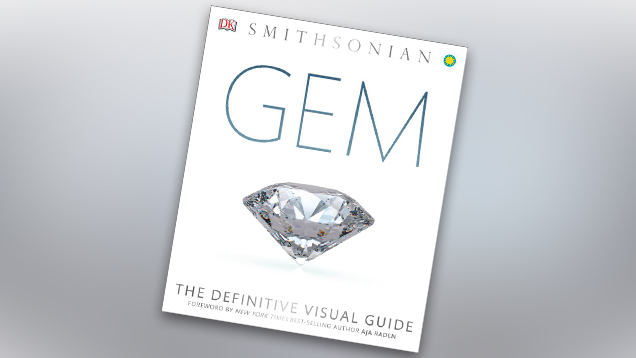Book Review: Gem: The Definitive Visual Guide

The first edition of Gem: The Definitive Visual Guide is a visual encyclopedia driven by spectacular images of world-class gems, artifacts, and jewels. Developed in association with the Smithsonian, with a foreword by jeweler and scientist Aja Raden, the book is a good resource for amateur to professional gemstone lovers.
Gem starts with an introduction to basic concepts of geology and mineralogy, the roots of modern gemology. It then moves to more specific descriptions of gemstone resources, mining, manufacturing, evaluation, and the concept of a jewel. The introduction is a quick reference for readers without a science background or familiarity with the gem and jewelry industry.
The main body of the book is divided into “Native Elements,” “Gemstones,” “Organic Gems,” and “Rock Gems and Rocks.” These titles are commonly used in comprehensive gemology publications and textbooks, but here the items under each one do not follow the standard alphabetical mineral list. “Native Elements” covers precious metals and diamond, though diamond is typically considered a gemstone. The famous Hope diamond is also described here.
The other three sections also introduce both gem species and special single stones. Images illustrate each gem species, rough stone, polished or faceted stone, and jewelry piece. The physical properties of each are also listed. Famous crown jewels, appealing artifacts, and jewels of significance or owned by historical figures or celebrities are detailed. From Byzantine to ancient Egyptian jewels, from the Maharaja of Patiala’s diamond and ruby necklace to the Chinese luxury birdcage of the Qing dynasty, and from King Ludwig II’s gold pocket watch to the Duchess of Windsor’s Cartier flamingo brooch, readers can not only learn the basics of gemstones but also enjoy a visual tour of jewelry history.
The jewels and artifacts are illustrated by high-resolution images and historic paintings. Some are even accompanied by a timeline tracing their history, as with the Crown of the Andes, for example. From around 1500, when the center emerald was attained, to 2015, when the crown was sold to the Metropolitan Museum of Art in New York City, it has been gradually modified and changed owners. These stories could lead the readers to more in-depth research on certain items.
The last hundred pages of the book are devoted to several very useful tools, including a color guide, a mineral and rock directory, a glossary, and an index. The mineral and rock directory is very handy for professionals for quick fact checking. The color guide and the index can help readers easily find related content in the book, while the glossary provides brief definitions of important concepts and terms.
Gem is a very visually appealing work and a good choice for any gemology or jewelry book collection. It would also be a meaningful gift for gem and jewelry lovers.
.jpg)


